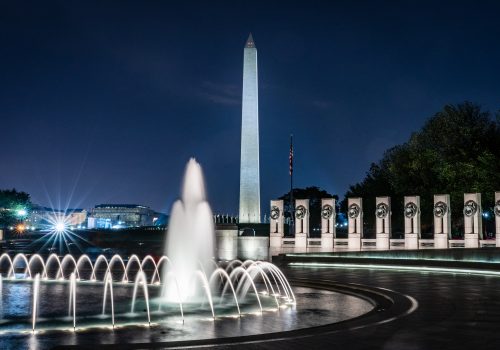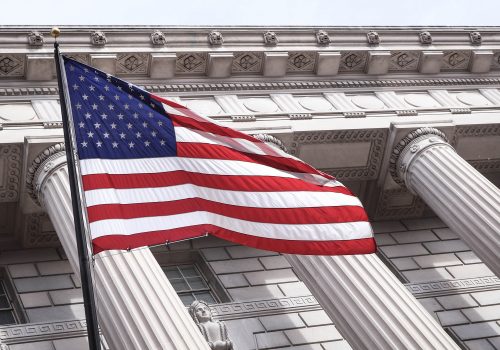IV. Process and personnel reforms
This chapter is part of a larger report—Economic might, national security, and the future of American statecraft. Read the chapters here or download the PDF.
This agenda, as important as it is, is unlikely to move forward without dramatic shifts in the policy process that has been in place for decades. To support this policy agenda, policymaking must shift from a siloed, often tactical approach, to one that is interdisciplinary, broadly focused, and consistently strategic.
The policymaking process will need to include clear lines of authority for directing a responsible pro-innovation policy, including mechanisms for deciding which sectors to support and overseeing those efforts. And the U.S government will need to supplement these reforms by attracting, training, and retaining people with diverse, multidisciplinary backgrounds to support highly informed, high-quality decision-making.
It is easy to call for change, but, as history has shown across a wide range of government reform initiatives, it is difficult and sometimes impossible to make them happen.1For example, past efforts to reform the National Security Council process have had mixed success and the defense acquisitions process has gone through nearly continuous cycles of reform, yet costs continue to rise. See, e.g., Charles P. Ries, Improving Decisionmaking in a Turbulent World (Santa Monica, CA: RAND Corp., 2016), 23–25, https://www.rand.org/pubs/perspectives/PE192.html; Obaid Younossi, et al., “Is Weapon System Cost Growth Increasing? A Quantitative Assessment of Completed and Ongoing Programs,” RAND Corp., 2007, https://www.rand.org/content/dam/rand/pubs/monographs/2007/RAND_MG588.pdf; and Thomas L. McNaugher, “Weapons Procurement: The Futility of Reform,” International Security 12, no. 2 (Fall 1987): 63–104, https://www.jstor.org/stable/2538813. As change looms on the horizon, time and again the forces of inertia — budgetary, bureaucratic, political — have emerged to quash such possibilities before they gained momentum. So we are under no illusion that change will be easy, and we accept that there are likely a variety of means by which these goals could be achieved.
At the same time, we are convinced that bold modifications to how policy is made and to who makes it will be necessary to ensure the spheres of economic policy and national security policy are fully integrated, thus securing America’s economic and political leadership going forward. What follows are a series of suggested reforms and guiding principles to precipitate the kind of radical change that is required.
Reform policymaking organizations and processes
For decades, policymaking structures have not been optimized for a converged environment. Making the secretary of the treasury a statutory member of the National Security Council in 2017 better integrated the policymaking community, but much more can be done. Within the White House itself, authority over the interconnected issues of economic and national security affairs has long been spread across multiple offices. The National Security Council is “the President’s principal forum for considering national security and foreign policy matters.”2“National Security Council,” The White House, https://www.whitehouse.gov/nsc/.
At the same time, the National Economic Council advises the president on domestic and global economic policy. The Council of Economic Advisers is “charged with offering the President objective economic advice on the formulation of both domestic and international economic policy,”3Council of Economic Advisers, The White House, https://www.whitehouse.gov/cea/. while the Office of Science and Technology Policy is responsible for providing “advice on the scientific, engineering, and technological aspects of the economy, national security … [and] foreign relations.”4Office of Science and Technology Policy, The White House, https://www.whitehouse.gov/ostp/. There are other groups that could be mentioned among those identified in the text, such as the American Technology Council or the Office of Management and Budget, the latter of which includes both an Office of the Chief Information Officer and the U.S. Digital Service. Each office contributes valuable input, but the bureaucratic separation between them is an impediment to developing national priorities or presidential decisions on innovation, economic statecraft, and related issues with implications for both economics and national security.5See, e.g., The Contest for Innovation, 14.
The U.S. government’s policy planning has similarly been fragmented across numerous strategy documents for decades. Strategies on national security and defense draw headlines,6The National Security Strategy of the United States; and “Summary of the National Defense Strategy of the United States,” Department of Defense, January 2018, https://dod.defense.gov/Portals/1/Documents/pubs/2018-National-Defense-Strategy-Summary.pdf. but various arms of the state also publish strategies on cyber security, spectrum management, and other issue areas.7See, e.g., Description of the National Military Strategy of the United States, The Joint Chiefs of Staff, January 2018, https://www.jcs.mil/Portals/36/Documents/Publications/UNCLASS_2018_National_Military_Strategy_Description.pdf; The National Cyber Strategy of the United States; The National Strategic Overview for Quantum Information Science, Committee on Science of the National Science and Technology Council, September 2018, https://www.whitehouse.gov/wp-content/uploads/2018/09/National-Strategic-Overview-for-Quantum-Information-Science.pdf; “Presidential Memorandum on Developing a Sustainable Spectrum Strategy for America’s Future,” The White House, Oct. 25, 2018, https://www.whitehouse.gov/presidential-actions/presidential-memorandum-developing-sustainable-spectrum-strategy-americas-future/; and The National Artificial Intelligence Research and Development Strategic Plan: 2019 Update, Select Committee on Artificial Intelligence of the National Science and Technology Council, June 2019, https://www.nitrd.gov/pubs/National-AI-RD-Strategy-2019.pdf. These documents, and the underlying efforts that guide them, serve an important role in setting priorities and expectations and can help each office understand what the others are doing. But in past administrations, they have rarely been well coordinated across disciplines.
Even when priorities are set, no single entity or person has responsibility for the execution of economic statecraft. The secretaries of defense and state and the director of the national intelligence have clear ownership over the other three aspects of national power — diplomacy, the military, and intelligence, respectively. By contrast, the tools of economic power and their use are split across agencies, including the treasury and commerce departments.8For a breakdown of export control authority, see, “The U.S. Export Control System and the Export Control Reform Initiative,” Congressional Research Service, updated January 28, 2020, https://fas.org/sgp/crs/natsec/R41916.pdf. As a result, there has long been insufficient top-down authority for the large-scale execution of national objectives in this arena.
These longstanding barriers have limited generations of policymakers. In the convergent environment, it will be ever more important to integrate national security and economic decision-making. To do so, the U.S. government should consider new approaches to developing policy and setting priorities for economic statecraft and innovation policy. These processes should include international coordination and should break down existing bureaucratic barriers, establish clearer policymaking authorities in the realm of economic competition, and develop mechanisms to coordinate research, development, and innovation.9A 2015 Government Accountability Office study, for example, found insufficient interagency coordination on the protection of critical technologies and called for the lead departments, including Treasury, Commerce, State, and Defense, to do more to coordinate their efforts to protect technologies. “Critical Technologies: Agency Initiatives Address Some Weaknesses, but Additional Interagency Collaboration Is Needed,” Government Accountability Office, February 2015, https://www.gao.gov/assets/670/668382.pdf.
Below we consider several distinct potential reform models to the policymaking process and structure, looking at methods to address economic statecraft and innovation both together and separately. Some of these are not novel approaches, and all of them have pros and cons, but each is worthy of consideration as a means of restoring, or in some cases creating, the required focus and necessary infrastructure where it is most needed.10Past efforts to work around existing agency structures and interagency processes have often struggled — for example, the tendency toward appointing “czars” or special envoys to address emerging challenges. See, Ries, Improving Decisionmaking in a Turbulent World.
I. Coordinate economic statecraft and innovation
In this model, the National Security Council would manage an interagency process to identify policy objectives and facilitate executive decision-making regarding economic statecraft. Likewise, the National Economic Council would establish an interagency process to coordinate innovation activities. Both offices would also be responsible for coordinating their efforts with international partners and with each other. Ultimately, they would be most effective, as discussed above, if they maintained open communication with the private sector and non-government leaders to get their input and their buy-in.
To coordinate economic statecraft policymaking, the National Security Council could create a new office headed by a deputy national security adviser and responsible for an interagency process on economic statecraft.11In the past, these responsibilities could have been given to the Office of International Economics. However, the administration has moved that office to the National Economic Council. There are pros and cons for doing so, and that decision is a reminder that the right policymaking process is often a moving target that is in need of consistent reevaluation and study. See, Robert C. O’Brien, “Robert C. O’Brien: Here’s How I Will Streamline Trump’s National Security Council,” Washington Post, Oct. 16, 2019, https://www.washingtonpost.com/opinions/robert-c-obrien-heres-how-i-will-streamline-trumps-national-security-council/2019/10/16/2b306360-f028-11e9-89eb-ec56cd414732_story.html. The office would be led by a senior official who would report to both the national security adviser and to the director of the National Economic Council. As with the former Office of International Economics, now part of the National Economic Council, this official would be a deputy assistant to the president on the National Security Council and deputy director of the National Economic Council. This new office would chair an interagency planning committee to ensure real-time cooperation, communication, and, hopefully, collaboration among operational agencies, bureaus, and offices, including the U.S. trade representative. And it would have a mandate to coordinate not only sanctions but also inducements — positive measures to promote international coordination and advance U.S. interests, such as foreign aid and infrastructure investments. Japan has taken a similar step with the express goal of coordinating more closely with the United States.12Shunsuke Shigeta, “Japan to Add Economic Team to National Security Council,” Nikkei Asian Review, Oct. 29, 2019, https://asia.nikkei.com/Politics/Japan-to-add-economic-team-to-National-Security-Council.

To coordinate innovation activities, the National Economic Council could establish an innovation office, geared toward facilitating interagency, public-private, and international communication and coordination on matters of innovation, as guided by the principles listed above.13As addressed elsewhere in this article, the executive branch has a unique capacity to facilitate information sharing and deconflict projects across public, private, and international domains. The same official in charge of the economic statecraft office at the National Security Council could lead this office as well. By wearing two hats, this person would be responsible for ensuring innovation and statecraft activities work in tandem.
In some respects, these two councils are the natural centers for interagency processes, given their existing interagency roles and the White House’s unique executive authority and ability to cut across bureaucratic siloes.14Colin Dueck, “The Role of the National Security Advisor and the 2006 Iraq Strategy Review,” Orbis 58, no. 1 (Winter 2014): 15–38, https://doi.org/10.1016/j.orbis.2013.11.007. They also are flexible by design — with decision-making structures directed by the president — making them ideal for addressing these rapidly evolving challenges.15McGeorge Bundy argued, quoting Robert Cutler, that the National Security Council’s flexibility was “a peculiar virtue” in a letter to Sen. Henry Jackson. Organizing for national security:
Hearings before the Subcommittee on National Policy Machinery of the Committee on Government Operations United States Senate, Vol. 1 (Washington, DC: GPO, 1961), 1336. In addition to practical benefits, establishing these two offices in the White House could also signal the importance of innovation and economic statecraft and of integrating economic and national security policymaking processes.
However, the flexible design of the councils could limit the permanence, depth, and potential sustainability of these efforts. Both policymaking structures would also have limited capacity to influence programming and budgeting, restricting the innovation arm in particular.16Both councils are non-operational and should remain that way. For a discussion of National Security Council roles, see, Kim Holmes, “Memo to a New President: How Best to Organize the National Security Council,” The Heritage Foundation, April 14, 2016, https://www.heritage.org/defense/report/memo-new-president-how-best-organize-the-national-security-council. Moreover, it is easy to picture these new offices turning into separate pockets within the National Security Council and National Economic Council staff. Should they become divorced from other council functions, they would not help increase the president’s decision-making capacity.17Luke Strange, The National Security Council: A Tool for Decision, American Enterprise Institute, March 2018, 10, https://www.aei.org/wp-content/uploads/2018/03/NSC.pdf. There is also the real risk of overly centralized decision-making processes and insufficient accountability, especially regarding innovation efforts, so a careful design would have to guardrail against these offices overstepping their bounds.18See, e.g., Colin Dueck, Strategic Planning for the New Administration, Hoover Institution, Dec. 15, 2016, https://www.hoover.org/research/strategic-planning-new-administration.
II. Address economic statecraft separately
As another possibility, the U.S. government could develop a cross-agency committee responsible for setting principles and directing traffic across the economic statecraft portfolio.19Alexander Bobroske, “Reforming the National Security Council,” American Action Forum, Dec. 21, 2016, https://www.americanactionforum.org/research/reforming-national-security-council/. It could be modeled on the Committee on Foreign Investment in the United States process and be chaired by a cabinet member.
This new committee would be responsible for strategic planning and setting policy priorities for the execution of economic statecraft and the various dimensions of the aforementioned agenda. Members could include senior leaders from relevant agencies and executive offices. Participating agencies, such as the Departments of Commerce and Treasury, may need to develop more extensive policy-planning capabilities to contribute to this process.20Eric Lorber has recommended that the Treasury Department establish its own office of policy planning. Lorber, Securing American Interests, 10.
Specifically, this new committee, like the Committee on Foreign Investment in the United States, would be complemented with a working group ideally composed of sub-cabinet officials from: the Departments of Treasury and Commerce offices involved in the rulemaking process for the Bureau of Industry and Security and the Office of Foreign Assets Control; the U.S. Trade Representative’s office and other White House offices; and the National Security Council and the National Economic Council. The committee could be housed either within the executive office or within an executing agency, as the Committee on Foreign Investment in the United States is, and motivated by strict timelines for action, recalling what makes the foreign investment committee most effective.
The committee would need to engage with the private sector to understand international threats, identify areas of need, and, to the extent possible, encourage private actors to accept some of the risks inherent to modern economic competition. There are many ways to do this, including through rulemaking processes or an advisory body made up of business leaders, academics, analysts, and former officials, which would issue regular reports and send representatives to high-level committee discussions. Participating agencies could also convene similar executive boards. As we noted previously, the private sector has in important role to play in addressing technology transfer, investment risks, and emerging dynamics, including cryptocurrencies and data governance. This committee should recognize that reality.

This type of structure would help establish clear executive direction over economic statecraft, as exists for other elements of national power. As such, it would need buy-in from participating agencies; authority to, at a minimum, set priorities for policy and rules; and clear oversight authority. However, it risks becoming another silo in the expansive bureaucratic landscape that is the executive branch. Its success would depend on presidential support, clear strategic goals, and the right personnel.
III. Promote innovation separately
Similar to the economic statecraft coordinating committee just described, an innovation coordinating committee would be responsible for working with agencies, the private sector and outside experts, as well as international partners to identify, communicate, and direct funding to innovation priorities with the goal of ensuring comprehensive research and development efforts.21The Reagan Institute’s task force on innovation recommended a similar body and outlined positive principles for its role, which we draw from here. The Contest for Innovation, 15. The committee would also help develop the types of international innovation programs described above.
Its members could include: senior agency leaders with knowledge of ongoing innovation work, such as the undersecretary of defense for research and engineering; White House representatives from the National Security Council, the National Economic Council, and other executive offices; and heads of major research laboratories. Given that it would be responsible for strengthening and motivating private sector innovation, this body would need a mechanism to ensure regular coordination across academia, national laboratories, private industry, and other innovation hubs. An advisory board, like that described in the previous option, may suffice. This new committee could also maintain a standing subcommittee of non-government advisers and could be housed either within the executive office or within an executing agency.
This committee risks running into many of the same problems as the economic statecraft committee, as well as the risk of overstepping its bounds and getting into the business of picking winners and losers. The investment principles outlined above would form necessary guardrails to its activities, as would congressional oversight and regular reporting on funding priorities.
A cross-disciplinary advanced research and development agencycould direct funding for innovation priorities and be responsible for promoting the development of technologies that maintain America’s innovation leadership. It would be the means to fund research and development projects that fall outside existing agency mandates and could direct funding across sectors. If modeled after DARPA, such an agency would set and execute its own investment projects, though it ought to be bounded by our investment principles. It would ideally replicate the successes enabled by DARPA’s autonomy and bottom-up governance structure and therefore encourage greater risk-tolerance among policymakers.22Erica R.H. Fuchs, “Cloning DARPA Successfully,” Issues in Science and Technology 26, no. 1 (Fall 2009): 65–70, https://www.jstor.org/stable/43315003. It could, moreover, serve the dual purpose of strengthening the innovation iron triangle and facilitating multilateral innovation initiatives.
A generalized research and development agency could also be the execution arm of the innovation committee described above. With knowledge of the research and development programs at each government agency, that committee would be responsible for ensuring projects are not duplicative; would set priorities for this agency’s work; and would receive congressional appropriations, earmarked for the research and development agency to distribute.
However, as multiple Government Accountability Office studies have found, DARPA’s model is most effective when pursuing defined technical goals in areas with either clear customer demand or existing expertise.23See, e.g., “Defense Science and Technology: Adopting Best Practices Can Improve Innovation Investments and Management,” Government Accountability Office, June 29, 2017, https://www.gao.gov/products/GAO-17-499; and “Defense Acquisitions: DOD’s Use of Other Transactions for Prototype Projects Has Increased,” Government Accountability Office, Nov. 22, 2019, https://www.gao.gov/products/GAO-20-84. It struggles in the absence of those conditions and when asked to translate research projects into programs of record or sustained development projects.24“Defense Science and Technology: Adopting Best Practices Can Improve Innovation Investments and Management.” A national research and development agency would need to overcome both these obstacles. And it would ideally receive not only clear strategic guidance about what sorts of projects it could fund but also hands-off oversight, which introduces risks of undue influence and cronyism.
The options outlined here are by no means exhaustive, and each has its advantages and disadvantages. But they all point to a set of guiding principles that should inform any effort to reform the policymaking process:
A variety of organizational models could adhere to these principles. None will be perfect, but whatever form it takes, the policymaking process must change the way it has operated for decades. The president should consider establishing a bipartisan commission to study and identify organizational and process reforms. The commission could be comprised of current and former government officials with experience in these issue areas, as well as business leaders and outside experts, and members could be appointed by both the White House and Congress. Its goal would be to propose new policymaking designs that would systematically integrate national security and economic policy, guided by the principles presented here. However, even with the right processes and organization, policymaking will suffer without the right people sitting around the table. That is the final component of this reform agenda.
Reform government talent management
To get the right people, personnel and talent management policies should evolve to include programs to attract, retain, and train people with different profiles: lateral, creative, out-of-the-box thinkers as well as substantive experts, particularly in science and technology. The range of policy responsibilities outlined above necessitates different competencies, but they all require cross-disciplinary thinkers, with a mix of technical and soft skills, often with non-traditional backgrounds. Some efforts have already been undertaken to draw this type of talent into civil servant roles in departments and agencies, producing pockets of technology talent in areas such as the U.S. Digital Service (located within the Office of Management and Budget) and 18F (located within the Technology Transformation Service at the General Services Administration), as well as tech-focused offices within the Intelligence Community and Department of Defense.
To ensure America’s primacy in this new era, these efforts will need to be accelerated. To begin with, federal agencies should exercise their substantial, but underutilized, hiring authorities to develop a stronger career workforce.25For example, agencies can rapidly hire people into AI-facing jobs and draw talent from outside traditional career pipelines. See, Interim Report, National Security Commission on Artificial Intelligence, 37. The pay gap between public and private sector jobs disincentivizes top talent from entering government jobs. Agencies could help overcome that obstacle and improve recruiting and retention numbers by providing greater access to continuing education and training — as the U.S. military does for uniformed personnel — and should consider offering alternative career pathways that support such talented civilian employees.26The “Section 809 Panel” proposed creative reforms to the defense acquisition workforce. Similar models could be considered in other agencies, including the Departments of Treasury and Commerce. See, “Section 809 Panel,” available at https://section809panel.org/.
At the same time, the executive branch ought to develop cross-disciplinary relationships and expertise through “joint” appointment structures. Similar to the military’s requirement for joint billets in order to be promoted, agencies could adopt a new model of “national security professionals” and make promotion to the senior executive service contingent upon cross-department experience.27Ries, Improving Decisionmaking in a Turbulent World, 44. Participating agencies could include the Departments of State, Commerce, Treasury, Defense, and even Justice, Energy, and Homeland Security. While the ideal professional experiences and backgrounds would vary by role, these sorts of joint career experiences would help prepare senior professional staff for the increasingly integrated spheres of economic and national security policymaking.
In addition, the federal government should develop far more robust partnerships with private industry to draw on its talent and ideas. Individuals participating in these partnerships could sign up for temporary, multi-year “tours of duty” or for more permanent arrangements that would place private sector talent into agencies on a longer-term basis. These partnerships could also facilitate the flow of ideas and solutions into the U.S. government, whether through short-term private competitions or through longer-term research and development relationships. Agencies could also establish fellowship programs, in the vein of the White House fellowships, to draw in talented young people with varied skill sets. These programs have their faults, but if well-managed and housed within a particular agency, multiyear fellowships could fill known gaps in agency workforces and bring in technologists, entrepreneurs, and other non-traditional talent. More broadly, the federal government must reform USAJOBs (the federal government’s online hiring portal) and reduce other unnecessary hiring barriers that might deter otherwise interested talent.28Inspired to Serve, National Commission on Military, National, and Public Service, March 2020, https://inspire2serve.gov/reports/final-report.
Similar arrangements should be established with universities and other institutions to promote the education of students committed to public service in a variety of fields. These students could either enter government to help shape the next generation of leaders or participate in the research and development necessary to help position the United States to compete and succeed in this new landscape. Such programs could be linked to scholarship or debt-forgiveness programs as referenced above. Other countries have already undertaken similar efforts. Israel, for example, handpicks young students with a high cyber aptitude to join Unit 8200 of the Israel Defense Forces.29Dov S. Zakheim, “Brains, not Brawn, Matter Most in the Next War — and We’re not Being Smart About It,” The Hill, Oct. 22, 2019, https://thehill.com/opinion/national-security/466679-brains-not-brawn-matter-most-in-the-next-war-and-were-not-being. This has significant knock-on effects, as those individuals often stay in the military long term and add their expertise to Israel’s public mission.
Personnel reforms should not be limited to career appointments and civil servants. Political appointments should draw from a more varied talent pool of people with unique track records of success and experience. Such individuals are needed to help confront ever more complex issues at the intersection of security, technology, and economics. Those with backgrounds in related issues, especially with cross-disciplinary and high-tech experience, will be best prepared to take on these challenges. Yet, this is where the current policies, pay limitations, and rigorous Senate ethics rules and confirmation processes can deter even the most patriotic of high-quality candidates from accepting appointments. These rules exist for good reason, and risks of corruption and unethical behavior must be balanced against the risks of not getting the right people. But in order to attract and retain the kind of talent that will be necessary for America to prevail in great-power competition, some dramatic changes will be required as highlighted in a recent study by Business Executives for National Security.30Making Senior Government Service More Attractive, Business Executives for National Security, May 2015, https://www.bens.org/file/policy—bens-impact-documents-/Government-Services-Report___May2015.pdf.
There is a great deal to be done. The world is changing in unprecedented and disruptive ways, as the coronavirus pandemic is making clear. To preserve America’s primacy, its political leaders must leverage the country’s unique advantages through policies that strengthen America’s innovative capacity, economic statecraft, and position as the leader and center of gravity of the international community while also making needed reforms to the processes and the workforce that guide such efforts.
To quote Samuel Huntington, “The ultimate test of a great power is its ability to renew.”31Huntington, “The U.S.: Decline or Renewal?” 90. We are optimistic that by taking these, and other, important steps, the United States will rise to this historic challenge.
Read the full report:
Image: Photo: Simon Fitall/Unsplash


